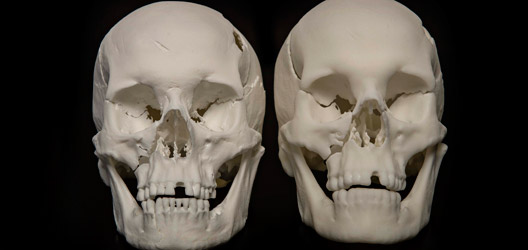
New Richard III 3D printed skull presented to Guildhall exhibition
Professor Russell Harris hands over the new skull to Senior Curator Laura Hadland.
A new and incredibly detailed 3D printed replica of King Richard III’s skull has been loaned by Loughborough University to the Leicester Guildhall exhibition, which charts the discovery of his remains in the city.
Experts from Loughborough’s School of Mechanical and Manufacturing Engineering were invited to make a replica of the King’s skeleton by the University of Leicester, who led the search for the lost monarch.
Loughborough transformed scan data into a 3D computer model and laser sintering – a technique that uses a high power laser to fuse small particles of materials into a mass that has a three-dimensional shape – was then used to create a physical replica of the skull.
The first version created by the Loughborough team has been on display at the Leicester City Council’s exhibition – ‘Richard III: Leicester’s Search for a King’ – at The Guildhall since February and is one of the key exhibits.
Since this time the team have continued their work on replicating the King’s skull, and using more in depth data and refined production techniques they have been able to create a stunning new copy.
The updated skull is vastly more detailed, illustrating even more clearly the injuries sustained by Richard III in his final moments.
Professor Russell Harris – head of the University’s Additive Manufacturing Research Group – is leading Loughborough’s involvement in the project. He said: “We are absolutely delighted with the new skull. It is incredibly more detailed than the previous version, and will be invaluable for future studies.”
The new skull was presented to Laura Hadland, Senior Curator for the Leicester Arts and Museums Service, and is now on display at The Guildhall exhibition.
Laura said: “85,000 people have visited the Guildhall exhibition so far and many of them have commented on how much the 3D skull model adds to their understanding of the battle trauma that the King suffered. We are hopeful that this higher resolution model will take this understanding even further.”
Professor Harris and his team are continuing their work to create a complete copy of Richard III’s full skeleton, which it is hoped will form part of the permanent visitor’s centre being created in Leicester, due to open next year.
−ENDS−